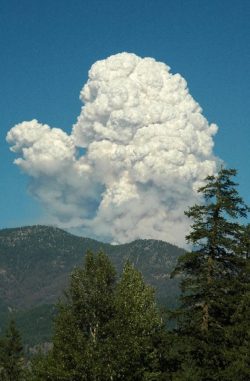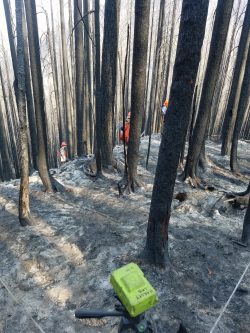
Wildfire season is already upon us. In 2018, roughly 1700 fires occurred in Washington, burning 500,000 acres of forested land and immediately affecting thousands of people in rural communities. Wildfires have a larger, regional impact too – long term exposure to smoke can increase the risk of heart and lung disease, as well as increase sensitivity to asthma.
So what’s in store for Washington this year as the 2019 wildfire season gets underway? We asked four of UW’s climate and wildfire experts to weigh in.
Wildfire season is here in Washington – how is this year shaping up compared to other years? What might we expect?
Brian Harvey, assistant professor in Environmental and Forest Sciences:
Wildfire season is certainly here. When you look at the historical record of large fire years in this part of North America, the trend corresponds well with snowpack. Lower snowpack means an earlier than average start for fire season. We have lower than average snow pack this year – the ingredients are here for a fire season that could be fairly active in Washington.
Crystal Raymond, climate adaptation specialist at the Climate Impacts Group:
The exceptionally dry March enabled several small fires to start in western Washington, much earlier than normal. Although some moisture returned to the region in Spring, western Washington is still drier than average and has an elevated potential for wildfire this season. This dry trend is expected to continue through July and August, and by July, northeastern Washington is also expected to have an elevated potential for wildfire.
Karin Bumbaco, assistant state climatologist in the Office of the Washington State Climatologist:
The Wildland Fire Potential Outlook from the National Interagency Coordination Center has increased chances for wildfires in western WA beginning in May throughout the summer. It is fairly unusual to see these elevated odds of fire this early in the season, particularly west of the Cascade Mountains. Winter as a whole was drier than normal in western WA and even with the impressive lowland snow we saw in February, our snowpack was below normal. On top of that, May was warmer and drier than normal in western WA. For these reasons, Governor Inslee declared a drought emergency in several watersheds, anticipating potential problems for water supply this summer. This translates into a potential increase in wildfire activity and associated impacts, like poor air quality.
Susan Prichard, research scientist in Environmental and Forest Sciences:
This chart shows us that the snowpack in North Cascades is lower than in previous years. In our region, dry summers generally correspond to more severe wildfire seasons but it’s not as simple as saying “when there is a dry spring there will be wildfires.” For example, the summer of 2015 was a record-setting wildfire year for Washington State with numerous lightning events and hot, dry windy days that led to explosive fire spread. However, an even drier spring in 2005 didn’t add up to a severe wildfire season because we didn’t have numerous fire starts lining up with extreme fire weather.
When we think about changing wildfire regimes, do other factors come into play besides increasing regional and global temperatures?
Karin Bumbaco:
There are lots of factors that determine the severity of the fire season, and one important ingredient is a fire ignition. Fires are typically classified as either lightning or human-caused, and the jury is still out on whether weather patterns will change in such a way where lightning-caused fires will increase in the future or not. Other important ingredients are extended periods of dry conditions, low humidity, and wind to help spread the fire.
Susan Prichard:
The majority of forested landscapes in eastern Washington have a legacy of fire exclusion. As we move into an era of warmer, drier summers with longer and often more severe wildfire seasons, many forests are chock-full of live and dead vegetation (called fuel) and predisposed to large fires. Through a combination of factors, including displacement of Native people (and the associated cessation of indigenous burning practices) as well as widespread livestock grazing in the late 1800s and early 1900s that reduced grass cover, fires became less frequent in our region. In the absence of fire, forests have grown denser and multi-layered, leaving them vulnerable to large wildfire events.

Brian Harvey:
In some areas of the state, past suppression of fires has led to forests that now have uncharacteristically high levels of fuel. This is particularly true in forests covering much of the east (dry) side of the Cascades, where risk of severe fire is greater now than it would have been naturally. On the west (wet) side of the Cascades, fires were historically less frequent but when they did occur tended to be large and severe because the fuel loads regularly accumulated over centuries between fires, naturally. But as climate warms, we could be seeing conditions more conducive to big fires occurring more frequently on the west side.
Crystal Raymond:
Precipitation, especially in the summer, is an important control over our fire season. Other important short-term factors include dry lightning storms, low relative humidity, high wind speeds, and east wind events that bring dry air from the interior to the coast. At longer timescales, changes in the vegetation – from management or climate change, for example – can also affect the fire regime. Some trees and plants are well adapted to fire and others are less so – an abundance of poorly-adapted trees result in larger, more severe fires.
How does your work help inform our understanding of wildfire risk and management?
Brian Harvey:
A really solid understanding of fire ecology has been developed over the years by many folks at UW and partner agencies in this region. Now we’re seeing forest fire regimes changing right in front of our eyes. We need to know not only how forests respond to fire, but also to disease and insect outbreaks. In my work, we study how fires and other forest disturbances operate, and then we measure how the forest responds. Are fires burning differently than they did in the past? What kind of forest is coming back after fire? Is it different than how forests responded for fires in the past? We then use these insights to inform approaches to forest management and co-develop new strategies with landowners and managers to promote forests and communities that are resilient to fire.
Susan Prichard:
I study the role of fire as a restoration tool. Forest managers in eastern Washington are successfully using a combination of forest thinning and prescribed burning to reduce fire hazard in fire-prone forests dominated by ponderosa pine and Douglas-fir. Through the reintroduction of fire, forests become more open with less fuel on the ground and fewer layers within their canopies. This change in structure leaves them much less vulnerable to summer wildfires and also more prepared to survive summer droughts and attacks by native insects such as bark beetles.
As we move into a warmer, drier summers in the Pacific Northwest, we need to increase the pace and scale of dry forest restoration projects. Forest management to reduce fire risk and increase the resilience of forests to fire really works. It is both humbling and inspiring to realize that Native people in our Region and elsewhere already knew these lessons and actively used fire to promote more open forest conditions and sustainably live within fire-prone places.
Crystal Raymond:
We are currently working with local, state, federal and tribal governments to increase understanding and action on wildfire risk in western Washington in a changing climate. In western Washington, the response options are less clear than they are in dry forest regions, and we are working with organizations there to better understand the appropriate response.
Karin Bumbaco:
The Office of the Washington State Climatologist monitors weather and climate conditions throughout the entire year, with a specific focus on monitoring for drought conditions.

